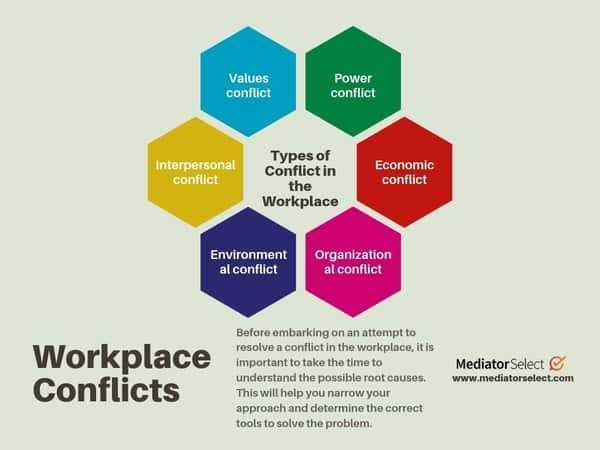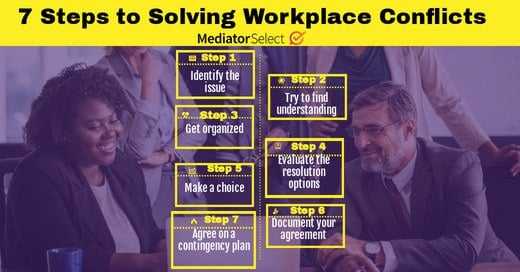7 Steps to Handle Workplace Conflicts Like a True Professional

Great teams are diverse, with varying perspectives, strengths, and weaknesses.
But these same features that help teams come up with innovative solutions also make it certain that, from time to time, people will disagree.
Unfortunately, conflict resolution is a skill that most employees and managers don’t get much, if any, training in.
In fact, 98% of managers surveyed believe that they need more training to deal with important work issues such as conflict resolution.
When people don’t learn how to deal with conflict ahead of time, there is a natural tendency to feel awkward and uncomfortable, which often leads people to avoid addressing the issue altogether.
Unfortunately, this only serves to make things worse. Conflict left to fester can turn into lost productivity or more sick days taken, and in more extreme cases it can lead to workplace violence or lawsuits. So, taking the time to learn how to end conflict in the workplace peacefully is vitally important.
Thankfully, there are a clear set of 7 steps you can take to effectively and reliably resolve conflict.
let's dive in and explore the resolution steps:
1. Types of Conflict in the Workplace
Before embarking on an attempt to resolve a conflict in the workplace, it is important to take the time to understand the possible root causes. This will help you narrow your approach and determine the correct tools for the job.
Some possible sources of workplace conflict include:
Values conflict – these types of conflicts stem from incompatibility in individuals core beliefs such as religion, ethics, or politics. While it is reasonable to assume that people aren’t necessarily openly discussing these topics in the workplace, a person’s core beliefs inform everything they do. Therefore, these topics can still be the source of the conflict, even if not directly.
Power conflict – when people are ambitious, they can quickly become jealous of other people attaining the power and recognition they think they deserve. This can manifest in perceived disrespect for another person’s authority, gossip, or even reduced effort if the ambitious person starts to believe they will never be recognized.
Economic conflict – the more resources someone has, the more they can do. Whether that means getting the best human resources for a team or getting more financial compensation for their time, conflict can arise when other people believe they are unfairly getting less.
Interpersonal conflict – each person comes to work with their own needs, goals, approach to work, and communication style. When these vary from one person to another, conflict can arise. For instance, some people may feel they need to receive frequent feedback from their manager to constantly improve their work. At the same time, the manager may feel they need independent employees who do not need feedback unless something goes wrong.
Organizational conflict – these types of conflicts stem from the structure of an organization and how employees report to each other. For instance, an employee may believe they need the freedom to make a certain choice to perform their job effectively, but the company is organized in a way that does not allow them that freedom.
Environmental conflict – when external pressures make someone’s life more difficult, this can show up in their work life. For instance, during the recession many workers were dealing with the stress of finances, family members losing jobs, and the fear of losing their own job.

2. How to Reframe Conflict?
As we discussed in the intro, people faced with conflict tend to feel uncomfortable and want to avoid dealing with it. To overcome this instinctual reaction, it’s important to evaluate how you think about conflict and reframe it to produce the best possible results.
Start by acknowledging that conflict is common and perfectly normal. Being involved in a conflict doesn’t say anything about you or the other person.
Next, think about how you have evaluated the situation so far. What is your part in the situation?
People tend to judge themselves on their intentions and others on their actions. So consider what people may think about you based on your actions and try to recognize that other people may have perfectly good intentions, even when their actions seem to say otherwise.
Then, asses some of your other beliefs about people using the growth mindset as a guide.
The concept of a growth mindset is usually used in the context of personal achievement. It describes a belief that an individual can become better through their positive actions. It is usually set in contrast to the fixed mindset, which is a belief that people are the way they are and cannot change.
While the growth mindset has been found to be vital for personal achievement, it can also help in conflict resolution. If you start the resolution process with the belief that both you and the other party can learn and grow as a result of deciding to take part in a mature discussion about the issue, this frame of mind will help you be more open to a solution.
Finally, think about the possible opportunities underlying the conflict. You may learn something about yourself that will improve your work life; you could learn how to work better with others and become a more effective team member; or you could learn more about the needs and expectations of the people around you.
The possibilities are endless.
Believe it or not, these possibilities make low-level conflict a healthy, positive thing. Therefore, managers should not focus their energy on completely eradicating conflict. Instead, everyone should learn how to approach conflict in a way that will end with the best possible results.
3. Seven Steps to Solving Workplace Conflicts
Once you’ve taken the time to understand the possible root cause of workplace conflicts and reframed how you view conflict in general, it’s time to learn how to handle workplace conflict using the following seven steps:
- Step 1: Identify the issue:
Offer a clear assessment of the issue as you view it and give the other person the opportunity to do the same. It is possible that you each have a completely different understanding of the core issue.
- Step 2: Try to find understanding
Ask the other party about their needs, interests, and what they hope to resolve by the end of these steps. The most important aspect of this step is that both parties put their differences aside to fully listen to what the other person wants to say.
- Step 3: Get organized
Once you have a better understanding of where the other person is coming from, organize what you’ve discussed so far into a list of possible solutions. Try not to react to suggestions and shoot things down right away. Instead, be open and allow yourself to be creative.
- Step 4: Evaluate the resolution options
When you’ve created an exhaustive list, it’s time to evaluate the options. Ask yourself what the pros and cons are of each option and which one maximizes the benefits for both of you.
- Step 5: Make a choice
Select the option or options that make the most sense for both parties. Be sure that the other person is just as confident in the solution as you are. If not, this jeopardizes the probability that they will follow through with the agreement, because they will feel less ownership over it.
- Step 6: Document your agreement
Don’t try to rely on your memory to follow the terms of your agreement, write down the commitments each person has made to ending the conflict. Refer to this document as needed to stop from falling into potentially destructive old habits.
- Step 7: Agree on a contingency plan
Include possible contingencies in the agreement in case one or both of you fail to follow through and determine how compliance will be monitored and evaluated.

4. How Workplace Mediation Can Help?
Sometimes, people are too close to a conflict to see things clearly, and even with the best of intentions, it can make it difficult to work through the steps without outside help. This is exactly what mediation is for.
Mediation formalizes the seven steps above by adding an expert, neutral third party – a workplace mediator – to the discussion to guide the disputing coworkers through the process. It has become a go-to tool for many companies. National surveys indicate 65% of companies have responded to workplace disputes using mediation, with a 90% success rate.
While workplace mediation introduces an additional cost, it is far less than letting the conflict continue or having to litigate a claim.
Mediation is:
- Flexible – the needs of the parties are always at the forefront of mediation, so if you need the process to move quickly or need to come up with an unconventional solution, those possibilities remain completely in your power.
- Amiable – mediation requires compromise and cooperation to be successful and takes the needs of both parties into consideration. This feature helps protect the relationship, which is vital when people must continue working together after the conflict is resolved.
- Confidential – if it comes to litigation, the matter will become public record. This is a risk to your business’ reputation and possibly to trade secrets if they must be discussed. But mediation is always confidential.
5. What is the role of mediator in workplace conflict?
Mediators are trained to be neutral in conflict. They will not take your side, but they will not take the other party’s side either.
Although they are impartial like a judge, a mediator is not a substitute for one. Instead, you keep the power to agree or disagree to any possible solution or propose your own creative solution.
The mediator is there to help both parties better understand each other, to identify the issues that are preventing resolution, and to propose possible ways to overcome those issues.
The mediator will also ensure that the discussion is balanced. If one person is taking over the conversation, the mediator will kindly give the other person an opportunity to respond before the first person continues. This way, everyone feels heard and nothing becomes too one-sided.
6. Conclusion
Workplace conflict can be awkward and difficult to deal with. And unfortunately, not many employees or managers are given the tools to properly deal with it. But it’s never too late to learn.
It starts with understanding the types of root issues that can arise in the workplace, then consciously reframing how you perceive conflict to get in the right mindset.
Once you’ve done the independent work, it’s time to approach the other party and evaluate the situation and possible agreeable solutions step-by-step. If you find that you and the other person cannot work through the situation alone, it might be time to get outside help.
A mediator can help you work through the issue without taking over the negotiation. You still have the power to make decisions about how the situation will be resolved, but the mediator will help you better understand the other person's needs and perspective.
If you need to find a qualified workplace mediator in your area, check out the MediatorSelect directory. You can ask questions, share your choice of mediator with the other party, and hire a mediator directly through the site.


